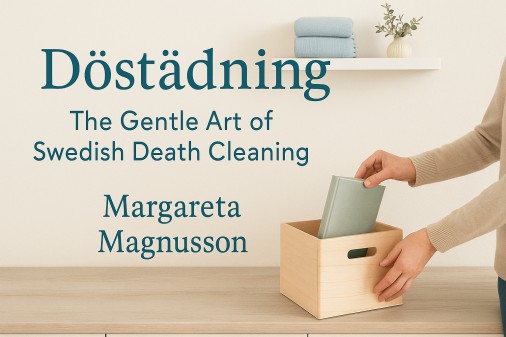Gentle Review of Döstädning by Margareta Magnusson
BOOKS REVIEW
Chaifry
10/1/20256 min read


Margareta Magnusson, a Swedish artist born in 1937, has spent her days painting and stitching textiles that add a splash of color to everyday life. Living in a cozy cottage by the Swedish coast, she draws from her years as a mother, grandmother, and someone who has seen loved ones slip away to share her thoughts on growing old with grace. Her 2017 book, Döstädning: The Gentle Art of Swedish Death Cleaning, published by HarperOne, is a short, friendly guide to sorting your belongings before it is too late for your family. A New York Times bestseller with over 500,000 copies sold, it has been called “a charming
manifesto” by The Guardian (2018) and “a quiet revolution” by The New York Times (2017), sparking a global trend of thoughtful decluttering. The book’s main idea is that death cleaning—going through your stuff slowly to lighten the load for your loved ones—is a loving act that lets you enjoy your remaining days with a clear head and lighter heart. It is a wake-up call to the ground reality that all the clutter in our homes and lives can hold us back, making it a must-read for its simple, caring tips on letting go. For Indian youngsters, it is like a friend over chai, saying sort out your mess before it sorts you out, especially when family expectations pile up like old trunks in the attic. This book invites everyone to see decluttering as a gift to those you love, a soft reminder in a world playing catch-up with simplicity and space.
Döstädning begins with Magnusson’s kind nudge: “Start now, and you’ll feel better right away” (Magnusson, 2017, p. 1). Magnusson argues that death cleaning is a gradual way of sorting your things so your family does not have to deal with the overwhelm after you are gone, using her own stories and easy steps as examples. “Death cleaning isn’t about dying; it’s about living fully” (p. 10). The book opens with the why: “We all have too many things, and it’s time to lighten the load” (p. 15).
Magnusson tells how she got started: “I began with my closet, one sweater at a time” (p. 25). “Hold onto what brings joy, release the rest” (p. 30). For clothes: “Ask if you’ve worn it in a year; if not, it goes” (p. 40). “Clothes carry memories, but not all need to stay” (p. 50). Books and papers: “Books are old friends, but some have outstayed their welcome” (p. 60). “Papers build up like worries; clear them bit by bit” (p. 70). “Old letters hold stories, but keep only the ones that warm your heart” (p. 80).
Kitchen and home: “The kitchen is the heart; keep it uncluttered” (p. 85). “A single sharp knife beats a drawer full of dull ones” (p. 95). “Pots and pans tell tales of meals shared; choose the ones that smile back” (p. 105). Photos and keepsakes: “Photos freeze moments; pick those that make you smile” (p. 110). “Releasing keepsakes opens room for new joys” (p. 120). “A single photo album is better than boxes of faded pictures” (p. 130).
Magnusson touches on the feelings involved: “Grief makes letting go tough, but it’s a kindness to yourself” (p. 135). “Tell stories to the items you part with” (p. 150). “Each object holds a memory; honor it before goodbye” (p. 160). For older folks: “Death cleaning is your kindness to the next generation” (p. 165). “Start little by little, and the happiness will come” (p. 180). “A lighter load means more time for what you love” (p. 190). “It’s easier to sort when you’re not in a rush” (p. 200). The book closes with a sense of peace: “A tidy home brings a tidy mind” (p. 195). “Death cleaning is the art of living well” (p. 210). “Less stuff means more space for what matters” (p. 225). “It’s not about loss; it’s about freedom” (p. 240). “Every item you let go is a step toward lightness” (p. 255). “In the end, it’s the memories that stay, not the things” (p. 265). Magnusson’s blend of humor, personal tales, and easy steps turns decluttering into a loving habit, one that wants to clear space for a fresh start.
Döstädning stands out for its friendly, light-hearted tone, turning what could be a heavy topic into a cozy conversation. Magnusson’s words are like a kind auntie’s advice: “Start now, and you’ll feel better right away” (p. 1) encourages without pushing. The book’s strength is its practical tips: “Hold onto what brings joy, release the rest” (p. 30) is straightforward, as The New York Times (2017) calls it “a charming manifesto.” The room-by-room plan, “A single sharp knife beats a drawer full of dull ones” (p. 95), fits busy lives.
The emotional side is overseen with care: “Grief makes letting go tough, but it’s a kindness to yourself” (p. 135) acknowledges the heart in the task. The warmth in her stories, “Tell stories to the items you part with” (p. 150), feels like a family ritual, like sorting Diwali decorations with tales from grandma. The book’s appeal crosses borders, speaking to anyone tired of clutter, whether in a Swedish cottage or an Indian flat.
But it is not without rough edges. The book assumes a Western setup: “Papers build up like worries; clear them bit by bit” (p. 70) works for solo homes but less for joint Indian families where things are shared. It skips deeper social angles: “Photos freeze moments; pick those that make you smile” (p. 110) overlooks how caste or tradition makes some items sacred, like a grandfather’s watch passed down. The cheerfulness, “A tidy home brings a tidy mind” (p. 195), can seem too sunny for folks dealing with poverty or tight spaces, where letting go is not always an option.
The advice, “If you haven’t worn it in a year, it’s time to say goodbye” (p. 40), is helpful but does not touch on emotional ties to clothes, like a sari from your wedding or a gift from a relative. Compared to The Life-Changing Magic of Tidying Up by Marie Kondo (2014), it is more about legacy than joy, but both share a soft spirit. Still, Döstädning is a sweet, useful read for those ready to lighten up, though it is less for those wanting cultural depth. The Guardian (2018) rightly says it is “a quiet revolution” for its ease and kindness.
Why Indian Youth Readers Must Read This Book
For Indian youngsters caught in the clutter of board exams, JEE coaching, and family expectations, Döstädning is like a friend over chai, saying sort your life’s mess before it buries you. The race for top marks is like piling up old papers: “Papers build up like worries; clear them bit by bit” (p. 70). Rote learning is like holding onto outdated books: “Books are old friends, but some have outstayed their welcome” (p. 60). This book’s a wake-up call to make space for what you really want.
The job market, with its cut-throat chase for spots, feels like a closet full of unworn clothes: “Ask if you’ve worn it in a year; if not, it goes” (p. 40). For youth from small towns or lower castes, “Death cleaning is a gift to your children” (p. 165) hits home, like easing the load on your family by letting go of old ambitions. The book’s simplicity, “Hold onto what brings joy, release the rest” (p. 30), inspires clearing out dreams that do not fit anymore, like choosing a startup over a “safe” government job.
For girls, facing “when will you marry” questions, “Releasing keepsakes opens room for new joys” (p. 120) is a quiet push to make space for your own path. The ground reality is that rote systems hoard facts without heart, leaving kids playing catch-up with their true selves. “Start little by little, and the happiness will come” (p. 180) says begin with one drawer, like sorting study notes to focus on what lights you up.
The book’s hope, “Death cleaning is the art of living well” (p. 210), wants to simplify for Diwali, keeping the lights but ditching the dust. “Less stuff means more space for what matters” (p. 225) is like letting go of “log kya kahenge” fears to chase your passion. “It’s not about loss; it’s about freedom” (p. 240) pushes for breaking free from family heirlooms that tie you down, like an old pressure cooker you do not use but cannot throw away. “Every item you let go is a step toward lightness” (p. 255) reminds you that small steps lead to big peace. “In the end, it’s the memories that stay, not the things” (p. 265) says what counts is the love, not the stuff. Döstädning teaches Indian youngsters to lighten their load, a guide for finding joy in a high-pressure world.
Döstädning is a sweet, wise guide to decluttering with kindness. For Indian youth, it is a mirror to cluttered lives, urging simplicity. This book’s a gentle call to live freely, perfect for anyone ready to let go.
